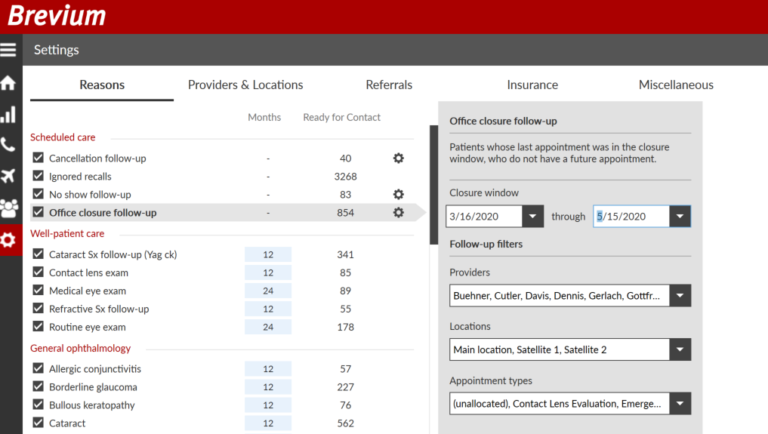The Brevium Blog

Mastering Patient Reactivation: Strategies for Long-Term Success
Most healthcare professionals understand that successful practices not only rely on acquiring new patients but thrive because of their loyal, established customer base. Studies show that depending on the industry, acquiring new customers could cost practices anywhere from five to 25 times more than simply retaining or reactivating current patients. With those numbers, why wouldn’t practices try a little harder to avoid patients slipping through the cracks? While most healthcare practices implement patient reactivation in some form, many practices struggle with finding the most effective strategies for long-term success; in fact, only 30 percent of businesses utilize effective techniques to win back their lost customers, often resulting in patient disengagement and missed opportunities. Losing patients is costly—both for your patients’ health and your practice’s bottom line. While some attrition is inevitable, its damaging effects can often be avoided through effective patient reactivation and engagement practices. Keep reading to explore the best strategies for mastering patient reactivation and regaining customer trust.
Understanding the Need for Patient Reactivation
Before you jump into reactivating your overdue patients, you must first understand what patient reactivation accomplishes and how the process impacts practice growth and patient outcomes. As to not get confused with reminders, recalls or retention, patient reactivation is the process of identifying patients lost or overdue for essential care and employing strategic outreach to bring them back for treatment. We’ve established that no practice is completely immune to patient turnover and patients can go inactive for several reasons that may or may not concern you. Here are a few common reasons patients might disengage from their healthcare journeys:
- Lack of health literacy or patient education: Patients do not understand their diagnoses and therefore, do not prioritize their treatment. Some patients without a background in healthcare may struggle to navigate the medical world and fail to realize the importance of continuous treatment.
- Communication breakdown: Patients can often forget about their treatment if they fail to hear from their providers or misunderstand their role in the treatment process. If they are told to return for treatment in a year and they 1) never hear from the practice again or 2) don’t understand why they need to return, patients can disengage quickly.
- No established trust: Failing to deliver on promises, poor treatment, and lack of communication can lead to patients not trusting their providers to take care of their needs.
- Patient economic/life situation: Many patients may not be able to afford their needed treatment or may have life situations that prevent them from receiving regular care.
- No access to data or records: Patients are “chronically unaware” of what’s happening with their health.
Effective patient reactivation isn’t just a recommendation, but a necessity for practices who want to experience long-term growth and success. Your established patients are the backbone of your organization because they have treated with you and know how your practice operates. And while patient reactivation is an effective tool for accessing untapped revenue streams and boosting your bottom line, building and maintaining trust with your patients should be at the forefront of your efforts so they feel comfortable coming to you for essential care—ultimately, creating a win-win situation for both practice and patient. Even with disengaged patients, practices have a 60 to 70 percent chance of selling again to existing or former patients compared to a five to 20 percent chance of converting a lead into a loyal customer; therefore, mindful patient reactivation and compassionate re-engagement should be a top-priority for organizational growth and success.
Strategies for Mastering Patient Reactivation
The main goal for your patient reactivation campaign should be to engage your patients in a way that will get them interested in their own healthcare and convert them back into loyal customers. Though most healthcare professionals understand the importance of patient reactivation, they don’t always employ the most effective strategies that will move their lost patients to action. The following are the best strategies for optimizing your patient reactivation efforts:
- Personalized Communication
Patient reactivation isn’t as simple as sending generic outreach hoping your overdue patients will respond. The process requires thought and consideration into not only how you are communicating with your patients, but also what you are communicating to them. There are four qualities that make an engaged patient:
- Educated: they understand their diagnoses/conditions and the recommended course of action.
- Understood: there is two-way communication between patient and provider that leads to knowing treatment options and ultimately, shared decision-making.
- Empowered: patients believe they can change their health outcomes and improve quality of life through recommended treatment.
- Active: they take action by seeking treatment based on personal findings and mutual understanding.
Effective patient engagement is at the heart of patient reactivation. Providing your inactive patients personalized communication through your practice’s many outreach channels is not only essential to boosting patient satisfaction and enhancing health outcomes, but also creates a more efficient practice workflow while driving revenue.
- Patient Segmentation & Provider Availability
Many practices make the mistake of trying to reactivate all their patients at one time and while this sounds good in theory, it is not always best in practice. Rather, practices should reactivate based on what type of patient they want to see. One of the unique qualities of Brevium’s software is the ability to mine your practice management system for overdue patients based on ICD-10 and CPT codes, allowing your practice to know who exactly you’re trying to bring back. Other identifiers to help you segment your patients for reactivation would be appointment history, insurance coverage, former provider, treatment history, and more. Another way to determine which patients to contact is discussing with your providers their schedule availability and which types of patients they are wanting to see first. Staggering your reactivation efforts allows for patients to schedule appointments so they can not only be seen quickly but also avoid provider overwhelm by overbooking their schedules.
- Multichannel Communication
Brevium conducted a study in 2019 that analyzed behaviors and habits of lost, overdue, high-risk and absentee patients and came to a resounding conclusion: making 4 to 5 contact attempts using multiple outreach methods over an extended period of time can increase patient reactivation rates by 81 percent. By employing a combination of texts, emails, automated calls, postcards and staff calls in its outreach, Brevium doesn’t let your efforts go to waste by ensuring your messages reach your patients. Because your overdue patients haven’t treated with you for a while, you may not have the correct phone number, address or email in your system; in fact, Brevium’s ALOHA study found that 95 percent of the patients analyzed could be reached by phone call and mail, but only 64 percent could be reached by text and an even lower 20 percent by email. Utilizing all of the communication channels ensures that at least one of your contacts will reach your inactive patients and through this outreach, you can find out which methods each individual patient responds to best.
- Measuring Success with Data Analytics
The patient reactivation process doesn’t end once you contact the patients. Rather, effective patient reactivation requires continual monitoring of your efforts to determine what works and potential areas of improvement. To measure your success, you’ll need a firm grasp on how many contacts were sent to inactive patients, reasons for the contact, communication channels used, patient engagement levels through appointments scheduled and kept, and ultimately, the revenue generated through your efforts. If the results are less than expected, return to the drawing board to determine which areas need refining and repeat the process. Data analysis is one of the best patient reactivation tools for learning your clientele because the data provides evidence to either support or debunk assumptions. Consider using a software to assist with data analysis to not only save your staff valuable time and effort, but to also provide accurate data by removing room for human error and bias.
- Leveraging Technology
Manual patient reactivation is a tricky, time-consuming process that most practices lack time to do properly and effectively. With an estimated 25 percent of a practice’s total patients lost or overdue, practices cannot afford to lack in this department. However, there is modern technology available to help practices streamline the patient reactivation process and focus more time on what truly matters: optimizing practice workflows and enhancing patient outcomes.
Take Brevium for example. Brevium is a patented patient reactivation technology that uses advanced algorithms to mine your practice management system for inactive patients. Then, the system employs strategic, automated outreach tailored to the individual patient and eventually, measures the success of any given contact method so you won’t have to do so manually; in fact, once the practice sets the patient parameters, the system runs on its own with hardly any need for staff intervention. Essentially, software like Brevium allows your practice to be hands-off while proactively re-engaging your high-risk and high-value patients.
Overcoming Challenges in Patient Reactivation
Any healthcare practice that has attempted patient reactivation could probably tell you the process is easier said than done and certainly doesn’t come without its challenges. The following are some common obstacles practices may face when reactivating patients:
Managing Resource Constraints
One of the biggest barriers to practices engaging in effective patient reactivation is the perceived notion of not having the resources for tackling such a project. While there can be many reasons for not taking efforts farther, there are three culprits that stand out among the rest: manpower, time and money. Medical practices are already extremely busy and the thought of dedicating staff time to another project may seem daunting. For other practices, they may not have the funds to add yet another marketing campaign to the mix.
Luckily, there is a three-in-one solution: patient reactivation software. With Brevium, practice administration only needs to set parameters for which patient types they want contacted and their preferred communication channels. From there, Brevium will run in the background and contact inactive patients without the need for additional staff work and monitoring—meaning the technology will efficiently perform patient reactivation without staff having to lift a finger. As for the cost, Brevium is not only modestly priced, but they only get paid if the software does its job. Brevium customers report reactivating more patients with the patented software than they have with any other process or technology. Because of this return, Brevium customers on average make $25 for every $1 they pay to Brevium. Don’t let software scare you off because it’s new and different—it may just be the answer to your reactivation problems.
Lack of Patient Motivation or Patient Resistance
Sometimes, patients have access to the right information and still don’t engage your reactivation attempts. Varying motivation levels among your patients can pose a complex challenge to healthcare providers trying to get their patients compliant with treatment. With some patients uninterested in receiving further treatment, the provider’s job is to then motivate these patients to become active participants in their healthcare journeys. As mentioned earlier, there are four steps to patient engagement: educated, understood, empowered, and active. Providers now must go the extra step and provide their patients with all the resources, information and if applicable, treatment options for them to make educated decisions on how to move forward. Effective patient reactivation is more than generic outreach—it’s meaningful engagement that requires strategic planning and compassionate solutions to your patients’ concerns.
Technological Barriers
Technological advancements have effectively re-shaped the face of the healthcare industry. From patient engagement software to telehealth options to electronic health records, patients have access to personalized healthcare unlike ever before. But what happens if your patients aren’t tech-savvy or don’t have access to it? Technological barriers can create major setbacks for practices depending on their patient base because even the best healthcare software won’t help a patient who can’t understand or use the technology. However, this challenge highlights the importance of using multiple communication channels in your outreach strategy—especially phone calls and direct mail—to ensure all your patients receive the information critical to making education healthcare decisions.
Conclusion
Patient reactivation should play a vital role for any practice who wants to experience long-term success; after all, it’s through patient retention and reactivation that medical practices truly thrive. By implementing effective patient reactivation strategies such as personalized communication, patient segmentation, multichannel communication, and data analysis in addition to investing in advanced reactivation technology, your practice can expect to see boosted reactivation rates and excellent ROI. These strategies have been proven to be effective not only through various studies and extensive research, but especially through Brevium’s customers who implement these strategies daily and consistently see unprecedented returns. Brevium’s unique patient reactivation technology is made to help both patients and practices alike by unlocking the revenue latent in overdue patients and efficiently filling providers’ schedules with high-priority patients—all while improving patient care and driving engagement. As the pioneer and leader in patient reactivation technology with over 18 years of refining their craft, Brevium arms its customers with the right tools to ensure improved health outcomes for their patients and revolutionary growth for their practices. Contact Brevium today for a demo.














